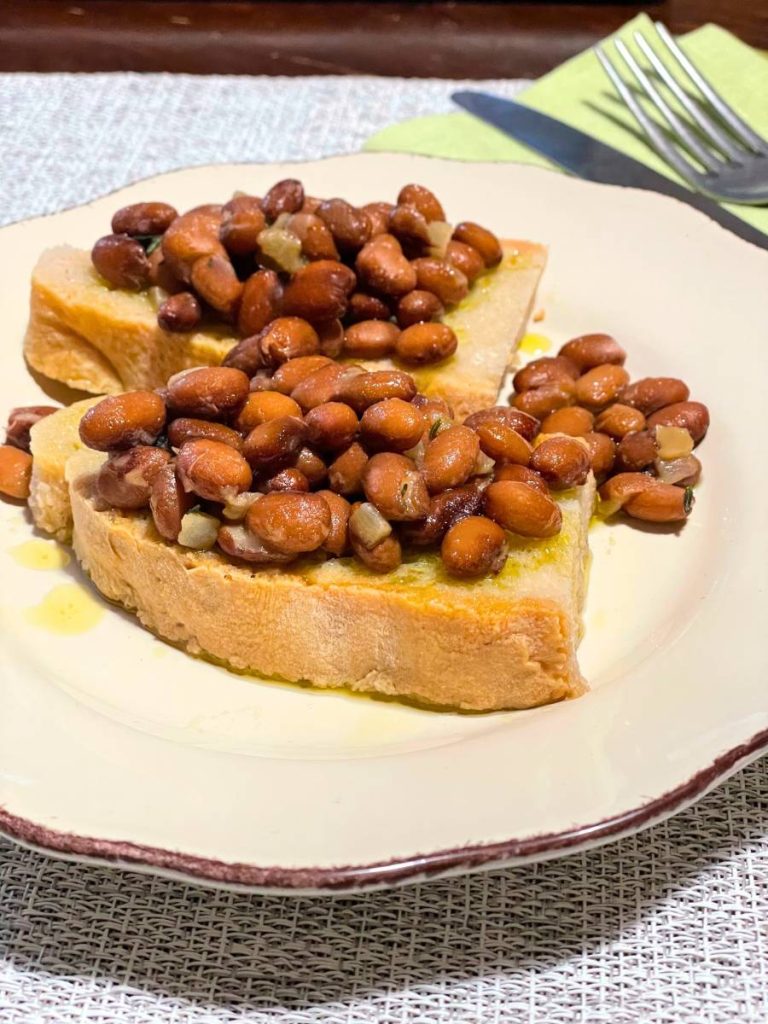Among the gentle hills of Alta Tuscia in Viterbo, where time seems to pass with the slowness of rural seasons, an ancient agricultural tradition is being revived today thanks to the project “Tourism and Culture – Taste the Tuscia”, promoted by the Chamber of Commerce of Rieti and Viterbo in collaboration with the Special Company Centro Italia. At the center of this rediscovery is a simple yet deeply identity-defining dish: the beans in greppa, made with a local variety that tells centuries of rural history, the Second Bean or Bean of the Stubble of San Lorenzo Nuovo.
This particular type of bean owes its name to the cultivation methods closely linked to the natural cycles of wheat. Sowing occurred exclusively in the third decade of June, right after the wheat harvest, using the crop residues – the so-called stubble – as a natural substrate. Hence the traditional names: “second”, as it was a subsequent harvest, and “of the stubble”, for the agricultural context in which it came to life. The harvest took place already at the end of August, thus allowing farming families to stock their pantries in view of autumn.
Today, this legume has been included in the basket of typical products of the Alta Tuscia Laziale Mountain Community, testifying to the cultural and gastronomic value it still represents for the territory. The beans in greppa – traditionally cooked with garlic, tomato, aromatic herbs, and a drizzle of local extra virgin olive oil – are the perfect example of how a poor dish can become a symbol of memory and identity. Through the promotion of products like this, the project “Taste the Tuscia” aims to promote a conscious tourism, combining flavors, landscapes, and traditions in an authentic and engaging experience.
I would like to introduce you to some recipes with legumes

- Difficulty: Very easy
- Cost: Economical
- Rest time: 12 Hours
- Preparation time: 5 Minutes
- Portions: 4 people
- Cooking methods: Stove
- Cuisine: Italian
- Seasonality: All seasons
- Energy 286.00 (Kcal)
- Carbohydrates 45.39 (g) of which sugars 2.58 (g)
- Proteins 11.85 (g)
- Fat 6.70 (g) of which saturated 0.74 (g)of which unsaturated 1.24 (g)
- Fibers 6.62 (g)
- Sodium 550.35 (mg)
Indicative values for a portion of 9 g processed in an automated way starting from the nutritional information available on the CREA* and FoodData Central** databases. It is not food and / or nutritional advice.
* CREATES Food and Nutrition Research Center: https://www.crea.gov.it/alimenti-e-nutrizione https://www.alimentinutrizione.it ** U.S. Department of Agriculture, Agricultural Research Service. FoodData Central, 2019. https://fdc.nal.usda.gov
Ingredients for beans in greppa
- 1.5 cups dried beans (Second Bean of the Stubble of San Lorenzo)
- 1 white onion (small)
- to taste extra virgin olive oil
- to taste salt
- 4 slices rustic bread (stale)
Tools
- Bowl
- Pressure Cooker
Preparation of beans in greppa
Soak the beans 12 hours before using them, optionally adding two bay leaves and a tablespoon of baking soda.
After soaking, boil the beans. If using a pressure cooker, they will be ready in 40 minutes, otherwise it will take about two hours. These beans, in particular, will remain quite firm.
Follow me on social media
my page Facebook my profile Instagram my page Pinterest
FAQ (Questions and Answers)
How to cook dried beans?
Soaking
Soaking reduces cooking time and improves digestibility:
➤ Long soak (preferred):
Cover the beans with plenty of cold water (3:1 water to beans).
Soak for 8–12 hours or overnight.
Drain and rinse well.
➤ Quick soak (alternative):
Bring the beans to a boil in water.
Turn off the heat, cover, and let sit for 1 hour.
Drain and rinse.
Cooking
Classic method (regular pot):
Place the drained beans in a large pot.
Cover with 3-4 times the volume of cold water.
Bring to a boil, then lower the heat.
Gently simmer with a partially open lid.
Without salt (can harden them) until almost done.
Cook for 45 minutes–2 hours, depending on the type.
Pressure cooker method:
After soaking, pressure cook for 15–30 minutes (depends on the type).
Be cautious with the liquid: do not exceed half the pot.
Flavors (optional but recommended)
Add onion, garlic, bay leaf, celery, or carrot while cooking to enhance the flavor.
Salt and acids:
Salt: add only in the last 10–15 minutes.
Tomatoes, lemon, vinegar: add only at the end of cooking, as they can slow down softening.

